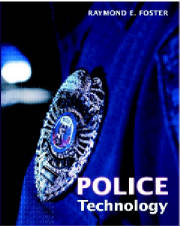|
|
Great Ideas - Secure Transactions |
|
|
|
|
Dear Raymond,
Please accept our thanks for the continued growth of
the newsletter and reader feedback. Indeed, we are rapidly
approaching 2000 subscribers!
In this issue we introduce retired police captain
Andrew J. Harvey, Ed.D. who pens an outstanding article on
the future of law enforcement organizations. Also,
Corporal Dave Blosser returns with a great follow-up
article on shooting techniques and range terms.
|
Building an Organizational Foundation for the Future
|
|
Andrew J. Harvey, Ed.D.
The modern world has
become a place of constant
change and transformation. In this environment,
success depends on how well organizations recognize
and adapt to change. Management theorist Tom Peters
put it very well when he said that the most successful
organizations in the future will be the ones that
"thrive on chaos." Those that cannot identify and act
on emerging issues are doomed to, at least,
inefficiency and ineffectiveness and, at most,
disaster and possibly even destruction.
What does this trend mean to law enforcement? With
its traditional, paramilitary structure, law
enforcement has proven slow to adapt to change. While
traditional methods have brought success in the past,
relying on these techniques in the future may be
dangerous
|
|
When Your Child is Missing
|
|
A Family Survival Guide

What do to if your Child is Missing provides
parents with the most current information on, and
helpful insights into, what families should do when a
child is missing. The first edition of this Guide was
written in 1998 by parents and family members who have
experienced the disappearance of a child. It contains
their combined advice concerning what to expect when a
child is missing, what needs to be done, and where to
go for help. It explains the role that various
agencies and organizations play in the search for a
missing child and discusses some of the important
issues that need to be considered. The Guide is
divided into seven chapters, each of which is
structured to allow information to be found quickly
and easily. Each chapter explains both the short- and
long-term issues and contains a checklist and chapter
summary for later reference. A list of recommended
readings and a list of public and private resources
appear at the back of the Guide. This third edition of
the Guide was published in 2004.
|
|
Police Technology
|
|

On April 25, 2006, Hi Tech Criminal Justice Online
launched a revised website for the text book, Police
Technology (Prentice Hall, July 2004). According to
Raymond E. Foster the book is used in over fifty
universities and colleges throughout the United States
and is under consideration for adoption in at least
sixty others. At the same time the book was in
production the original website was also being
developed. However, the initial website was parked as
a sub-domain under Hi Tech Criminal Justice Onlines
primary website.
Throughout the last 18 months the content of the
website has grown as has the use by students and
professors. The companion website offers students
additional articles, resources, cases studies and web-
based explanations for the key terms within the text.
Additionally, behind a password protected site
professors can find supplemental instructional
material such as example syllabi, PowerPoint
presentations for each chapter and hyperlinks to
relevant videos, journals and web-based resources.
|
|
Management of Dead Bodies After Disasters
|
|
A Field Manual for First Responders

Management of the dead is one of the most difficult
aspects of disaster response. It has profound and
long-lasting consequences for survivors and
communities. Globally, disasters claim thousands of
lives each year. However, care of the deceased is
often overlooked in disaster planning and the absence
of guidance for first responders has recently been
highlighted following several large disasters. This
Field Manual for First Responders presents simple
recommendations for non-specialists to manage the
recovery, basic identification, storage and disposal
of dead bodies following disasters. It also makes
suggestions about providing support to family members
and communicating with the public and the media.
This manual will be useful during the immediate
response to a disaster and where forensic response is
unavailable. Furthermore, it will be useful for those
preparing mass fatality disaster plans. The
recommendations are relevant for local, regional and
national authorities as well as for non-governmental
organizations. The principles outlined in this
document are being implemented and promoted by a
variety of organizations, including the Pan American
Health Organization, the World Health Organization,
the International Committee of the Red Cross and the
International Federation of Red Cross and Red Crescent
Societies.
|
|
Bomb Making Video
|
|
|
In February 2006, remnants of the Taliban detonated a
Improvised Explosive Device (IED) damaging an American
vehicle. The SITE Institute obtained a short-video,
produced by the terrorists, of the bombing. Perhaps
the most instructive part for law enforcement and
security personnel is the first half where the making
of the bomb is filmed
|
|
NCIS internship program
|
|
|
The NCIS internship program is a dedicated hands-on
experience designed to provide educationally related
work assignments for students in a non-pay status.
based upon their background and experience, interns
are assigned to functional areas such as criminal
investigations, information systems, government
relations and public affairs, administrative services,
computer crimes, strategic planning, personnel
services and operations, criminal intelligence,
forensic sciences.
|
|
Visual Database
|
|
Extremist Symbols, Logos and Tattoos
The Anti Defamation League (ADL)
maintains a Visual
Database of Extremist Symbols, Logos and Tattoos on
the Law Enforcement Agency Resource Network. It is an
Open Source (OSINT) webpage. The ADL also has several
webpages devoted to officer safety as it relates to
extremist groups.
|
|
Firearm Training Terms
|
|
David Blosser
 Police trainers traditionally teach level and equal
light bar sight picture, where your focus is on the
front sight. This is only one aspect of what your
focus should be to aim a firearm. Keep in mind the
goal is to simply place accurate hits onto your
intended target. Aiming is simply pointing your gun at
the target and holding it there until the round is
fired. Police trainers traditionally teach level and equal
light bar sight picture, where your focus is on the
front sight. This is only one aspect of what your
focus should be to aim a firearm. Keep in mind the
goal is to simply place accurate hits onto your
intended target. Aiming is simply pointing your gun at
the target and holding it there until the round is
fired.
You should always start with a complete target
focus. If you do not see the threat in the first place
nothing else really matters. Once you see your threat,
you need to have the skill to know exactly what it is
you need to focus on to make your hits. If your threat
is close you may not need to move your focus off of
your threat at all. If your threat presents a
difficult target you may need that clean crisp front
sight focus.
|
|
Leadership: Texas Hold 'em Style
|
|
|
Using poker as an analogy for leadership, Captain
Andrew Harvey, CPD (ret.), Ed.D., and Lieutenant
Raymond E. Foster, LAPD (ret.), MPA found the right
mix of practical experience and academic credentials
to write a definitive book for leaders. Most often
leaders find they are given a set of resources
people, equipment, funds, experience and mission.
As Foster noted, You are dealt a certain hand. And,
how you play that hand as a leader determines your
success.
Pre-order Today! |
|
|
